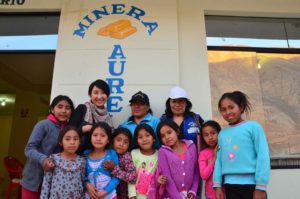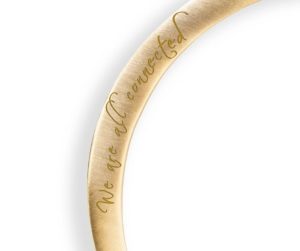
Do you know where the gold in your jewelry comes from?
Following the success of our recent Pure Earth Pure Gold Benefit Bash, we think many more people will begin to ask that crucial question and demand that more be done to break the toxic connection between between gold and mercury.
The benefit — including the auction of jewelry created by over 20 leading designers using mercury-free, Fairmined gold — raised over $350,000 to help support our efforts to reduce global mercury poisoning by training small-scale gold miners in mercury-free mining methods. Due to the generosity of our supporters, we can now accelerate training and mercury cleanup activities in more than seven countries affecting 260,000 lives!
Our collaboration with designers and the jewelry industry, including the Council of Fashion Designers of America (CFDA), Ethical Metalsmiths, Hoover and Strong, and the Alliance for Responsible Mining and their Fairmined label, has been eye opening. They are all part of a growing movement calling for more responsible sources of gold. And their efforts going forward will play a key part in our goal to reduce mercury poisoning from gold mining.

“I think most designers and consumers do not think about it. I think many are concerned over the origin of their diamonds, as conflict diamonds have been so prominent in the media, but do not consider the origin or process of gold because they are simply unaware of the process and who created it.” — designer Dana Bronfman.

“Designers are the people that take everything in the world from an idea to existence and because of this, designers have a huge responsibility to think about the footprint they are leaving behind.” –– designer Melissa Joy Manning.
Follow the Inca
Today, 30% of mercury emissions come from artisanal gold mining. But it does not have to be so. It is widely believed that the Inca did not use mercury in the gold extraction process. Mercury-free techniques exist. They just seem to have been forgotten.
In the Philippines, miner Leoncio Na-Oy rediscovered a century-old method of gold extraction without mercury. He now works with Pure Earth to test and teach this technique to artisanal gold miners in Peru, Bolivia Mongolia, and other countries.
Because different methods are viable in different mining locations, the challenge is to find a mercury-free technique that works for each mining community. The good news is that in many cases, we have found that mercury-free methods are capable of extracting even more gold from ore.

What this means is that when done correctly, artisanal gold mining can provide a good and safe living for 15 million artisanal gold miners.
But they are not the only ones at risk. Mercury travels far and wide, dropping in oceans and rivers, contaminating seafood worldwide. The message on designer Judi Powers‘ mercury-free bracelet, inscribed at the request of actress Daphne Zuniga, says it all — “We are all connected.”

Trend for 2016: Ethical Sourcing
With ethically-sourced materials being identified as a trend for 2016, Pure Earth will be working with the jewelry industry to explore ways to stimulate demand for mercury-free gold.
“… education within the industry is very important, but the most important education is to the public. Back in the 90’s, the Platinum Guild was hugely successful in getting platinum popular again, and it did this not by education and marketing to the jewelry industry, but to the consumer. People went into jewelry stores asking for platinum, so the jewelers had to sell it. The same applies here. If people go into stores demanding mercury-free gold, then jewelers will supply it because they are responding to consumer choice.” — Hoover and Strong
By tackling the problem from both the supply and demand side, we will potentially be able to eliminate the largest source of global mercury emissions that come from artisanal gold mining. And that would be mean less mercury in the environment, less contamination of seafood worldwide, and less mercury poisoning.
In the meantime, the toxic legacy of years of mercury use will linger.
“From the polluting of almost every river in the Sierra Nevada to the poisoning of the fish we eat, California’s golden legacy is a cautionary tale of the long term costs, often unattended to, in the fever for mining gold…

… I think the majority of designers and consumers remain woefully ignorant of the damaging effects associated with gold mining. Even when they are aware, there are very limited options and I think most designers have a difficult time figuring out how to change their business model to support more care driven standards.” — Martin Taber, Taber Studios, President of Ethical Metalsmiths.
But many designers are already leading the way.
“I do what I can to engage in the activities and processes that I hope and believe will help, including using recycled and Fairmined precious metals; sourcing recycled, conflict-free and ethically sourced gemstones; and doing business with companies and individuals who take it upon themselves to source and invest in sustainable materials and practices.” — designer Judi Powers

“The more questions we can ask and the more we become informed, the less we allow unsafe manufacturing to damage our planet.” –– Phoebe and Annette Stephens of Aandra Neen

It means so much to design with material that not only supports Fairmined-certified communities today, but also will provide an education and safer foundation for other artisanal miners in the future — Wing Yau, WWAKE
I felt it was worth working with gold the right way… I wanted to be part of something that the public needs to know about…” — designer Stephen Dweck

We would like to thank all our sponsors, friends and supporters for helping to make the Pure Earth Pure Gold Benefit Bash such as success, raising crucial funds to fight toxic pollution. And a special thanks to all the designers who collaborated with us:
Bario Neal
Caitlin Mociun/ Mociun
Dana Bronfman
1-100
SAMMA
JefHoo
Judi Powers
Judy Geib
Kate Jones/Ursa Major
Martin Taber/Taber Studios
Melissa Joy Manning
Merzatta
Nialaya
Pamela Love
Phoebe & Annette Stephens/Anndra Neen
Pili Restrepo/PR Series
Randi Mates/ Aesa Jewelry
Scosha/ Scosha Woolridge
Sharon Pedrini/Chandally
Sophie Buhai
Stephen Dweck
Toby Pomeroy
Wing/WWAKE





